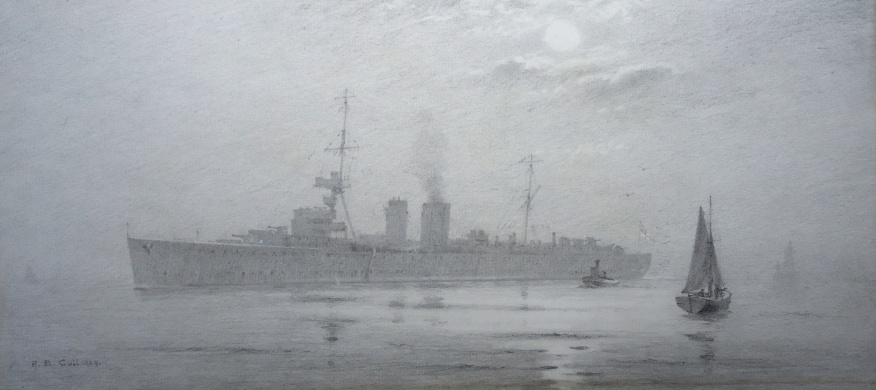HMS ADVENTURE - the Royal Navy's first purpose built minelayer
Alma Claude Burlton Cull (1880-1931). Pencil drawing signed A B Cull and dated 1929 (lower keft).
6 1/2 x 14 1/2 ins (16.5 x 37 cms) approx
Price on application
This original has been sold and is no longer available.
First appearing in the 1921 Naval Estimates, HMS ADVENTURE (the 20th of the name in the Service's history) was to be the RN's first vessel to be designed and built as a minelayer. The Canadian Pacific Railways' liner PRINCESS MARGARET had been taken up by the Admiralty in December 1914 to be converted into a minelayer and such was her value during the war years that a purpose built ship was an obvious contender for a share of what was then the shrinking Naval Votes of the 1920s. She was laid down in Devonport Royal Dockyard in November 1922 and first entered service in 1927. Her pre-war commissons saw her serve with the Home, Atlantic, Mediterranean and China Fleets and she was used extensively to practise those fleets in mine field avoidance and other related tecniques.
With a length overall of 520 feet and a displacement of 6.740 tons ADVENTURE was officially described as a "cruiser-minelayer" but her relatively light armament of four 4.7 inch guns precluded her her employment on cruiser duties, gun power and ammunition weight having been sacrificed for mine-laying capacity. She carried some 350 mines of various types which were laid through ports on either side of the stern, an operation which required precision and a relatively slow, loitering speed: this of course made her vulnerable to attack or capture and so she was given engines which delivered 40,000 shp and a speed of some 27 knots if required.
Predictably she had a very busy Second World War (and was joined by other purpose built minelayers) and it wasn't until July 1947 that she was finally placed on the disposal list.
A B Cull is well known as a marine artist of very considerable ability and although his water colours and oils - though relatively rare - are to be found, a pencil drawing of this maturity, signed and dated 1929, has never before been seen by this commentator. Was it perhaps executed for ADVENTURE's captain of 1928-30, Captain J H D Cunningham MVO, subsequently to become Commander-in-Chief Mediterranean during the war and namesake of A B Cunningham, also Commander-in-Chief Mediterranean during WW2?
